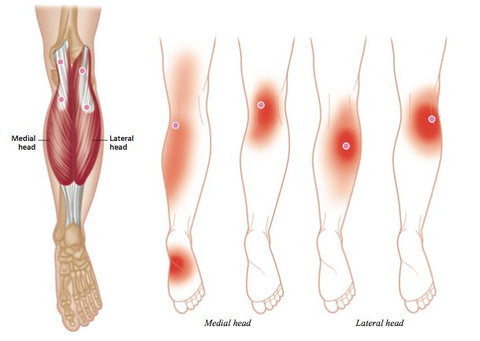Trigger Point Therapy - Treating Plantar Fasciitis
Treating Plantar Fasciitis
See also - Taping for Plantar Fasciitis
Around 10% of people experience Plantar Fasciitis at some point in their lives
One of the common misconceptions about trigger point therapy is that it is effective for short term pain relief only.
This plainly isn't true and Plantar Fasciitis (a nasty condition as anyone who has had it will tell you) is one of those conditions where we repeatedly find that we are able to provide both temporary and long term relief.

Gastrocnemius - Common Trigger Point Sites
Plantar Fasciitis is a common disorder, which can develop in one or both feet, and causes heel pain (usually acute).
It is the most frequent injury of the Plantar Fascia and refers to an inflammation of a thick band of tissue that runs across the bottom of the foot and connects the heel bone to the toes.
The plantar fascia supports the arch of the foot and if strained, becomes weak, swollen and inflamed.
Repeated strain can bring about small tears in the ligament causing pain and swelling, and your clients will report pain when they stand or walk.
This is one of those conditions where the client will usually have visited a family doctor; been left feeling dissatisfied; and researched on the internet, or heard from a friend that manual therapy could probably help.
Due to the high levels of pain and discomfort experienced by the majority of sufferers, clients tend to be highly motivated to seek treatment.
Thankfully, in most cases there's a lot that we can do!

What are the Symptoms of Plantar Fasciitis?
Clients will generally report feeling a sharp pain that usually occurs with their very first steps in the morning.
Once the foot limbers up, the pain of Plantar Fasciitis is known to decrease, but has been noted to reappear after long periods of standing or after getting up from a seated position.
Sudden stretching of the sole of the foot may increase the pain. It's worth noting that in extreme cases, symptoms include numbness, tingling and swelling.

Soleus - Common Trigger Point Sites and Referred Pain Patterns
Who is Prone to Plantar Fasciitis?
Whilst Plantar Fasciitis most commonly arises in older people, it may also occur in younger individuals who are on their feet for many hours of the day.
It is particularly common for runners to experience Plantar Fasciitis.
These cases often occur where the client has started running on a different surface to the one they're used to, or a switch to a different style of footwear.
In addition to age, poor footwear, obesity, and lack of physical exercise, Plantar Fasciitisa is known to affect individuals with extreme inward rolling of the foot, which is connected with flat feet.
Differential Diagnosis - What else could it be?
Here’s a list of other conditions which can present with similar symptoms:
Bone Issues:-
• Stress fractures
• Tarsal tunnel syndrome
• Bone spurs (heel)
• Broken ankle/broken foot
• Referred pain from the low back (S1 radiculopathy)
• Severs disease (Children/youth)
Inflammatory:-
• Gout• Osteomyelitis
• Pseudogout
• TB
• Pagets disease of the bone
• Osteoarthritis
• Reactive arthritis
• Psoriatic arthropathy (from psoriasis)

Treatment - Trigger Point Therapy
Plantar Fasciitis is typically associated with trigger points in the Gastrocnemius, Soleus, Plantaris, and Quadratus Plantae muscles.
Theses trigger points are all pretty accessible and clients should be encouraged to work on them at home between treatments as part of a comprehensive treatment program.
This should usually include stretching, strengthening exercises, and often simple lifestyle changes.
Links
Find a Trigger Point Professional in your area
More Articles About Plantar Fasciitis
Dry Needling for Trigger Points
Certify as a Trigger Point Therapist
This trigger point therapy blog is intended to be used for information purposes only and is not intended to be used for medical diagnosis or treatment or to substitute for a medical diagnosis and/or treatment rendered or prescribed by a physician or competent healthcare professional. This information is designed as educational material, but should not be taken as a recommendation for treatment of any particular person or patient. Always consult your physician if you think you need treatment or if you feel unwell.
About Niel Asher Education
Niel Asher Education (NAT Global Campus) is a globally recognised provider of high-quality professional learning for hands-on health and movement practitioners. Through an extensive catalogue of expert-led online courses, NAT delivers continuing education for massage therapists, supporting both newly qualified and highly experienced professionals with practical, clinically relevant training designed for real-world practice.
Beyond massage therapy, Niel Asher Education offers comprehensive continuing education for physical therapists, continuing education for athletic trainers, continuing education for chiropractors, and continuing education for rehabilitation professionals working across a wide range of clinical, sports, and wellness environments. Courses span manual therapy, movement, rehabilitation, pain management, integrative therapies, and practitioner self-care, with content presented by respected educators and clinicians from around the world.
Known for its high production values and practitioner-focused approach, Niel Asher Education emphasises clarity, practical application, and professional integrity. Its online learning model allows practitioners to study at their own pace while earning recognised certificates and maintaining ongoing professional development requirements, making continuing education accessible regardless of location or schedule.
Through partnerships with leading educational platforms and organisations worldwide, Niel Asher Education continues to expand access to trusted, high-quality continuing education for massage therapists, continuing education for physical therapists, continuing education for athletic trainers, continuing education for chiropractors, and continuing education for rehabilitation professionals, supporting lifelong learning and professional excellence across the global therapy community.

Continuing Professional Education
Looking for Massage Therapy CEUs, PT and ATC continuing education, chiropractic CE, or advanced manual therapy training? Explore our evidence-based online courses designed for hands-on professionals.


















